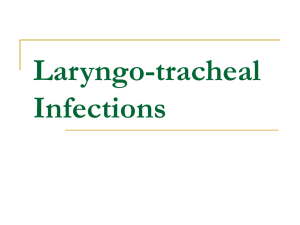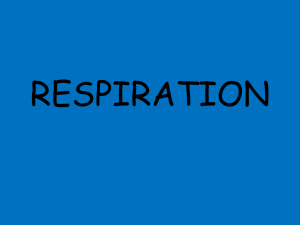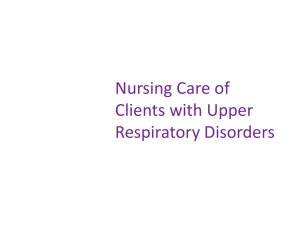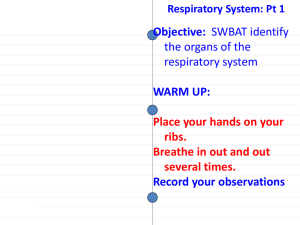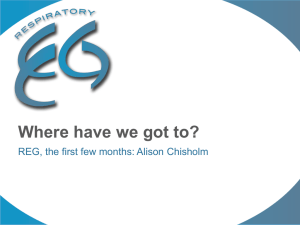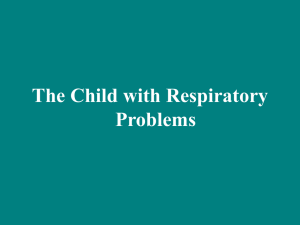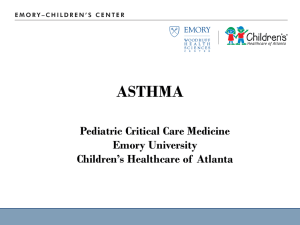Nursing Care of the Pediatric Individual with a
advertisement
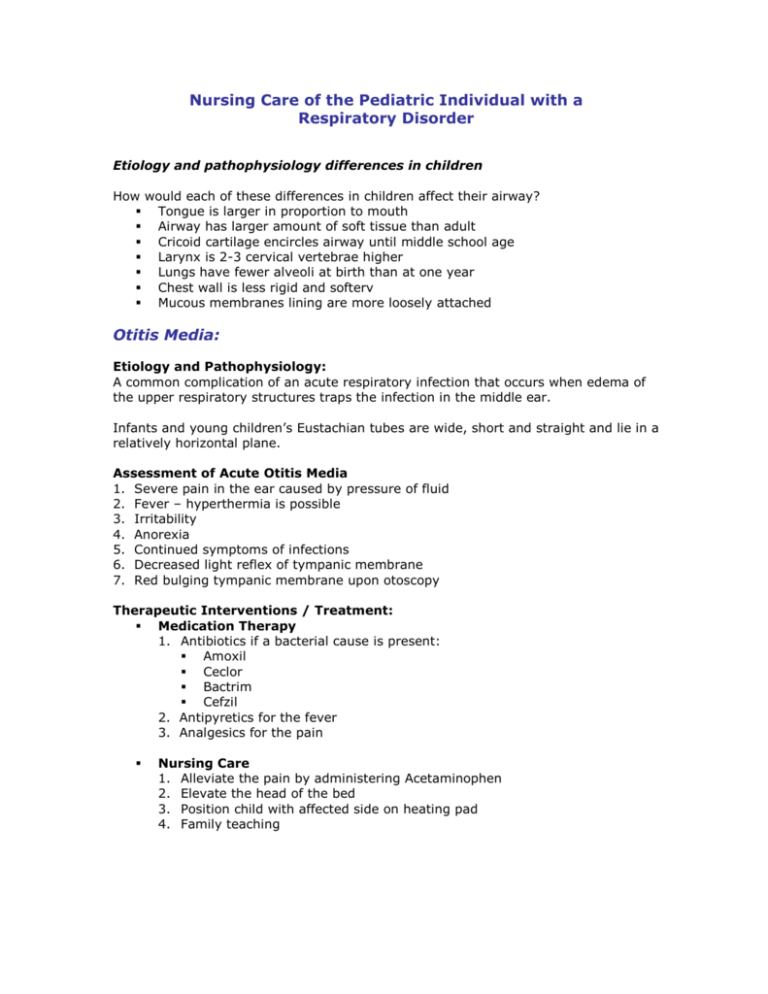
Nursing Care of the Pediatric Individual with a Respiratory Disorder Etiology and pathophysiology differences in children How would each of these differences in children affect their airway? Tongue is larger in proportion to mouth Airway has larger amount of soft tissue than adult Cricoid cartilage encircles airway until middle school age Larynx is 2-3 cervical vertebrae higher Lungs have fewer alveoli at birth than at one year Chest wall is less rigid and softerv Mucous membranes lining are more loosely attached Otitis Media: Etiology and Pathophysiology: A common complication of an acute respiratory infection that occurs when edema of the upper respiratory structures traps the infection in the middle ear. Infants and young children’s Eustachian tubes are wide, short and straight and lie in a relatively horizontal plane. Assessment of Acute Otitis Media 1. Severe pain in the ear caused by pressure of fluid 2. Fever – hyperthermia is possible 3. Irritability 4. Anorexia 5. Continued symptoms of infections 6. Decreased light reflex of tympanic membrane 7. Red bulging tympanic membrane upon otoscopy Therapeutic Interventions / Treatment: Medication Therapy 1. Antibiotics if a bacterial cause is present: Amoxil Ceclor Bactrim Cefzil 2. Antipyretics for the fever 3. Analgesics for the pain Nursing Care 1. Alleviate the pain by administering Acetaminophen 2. Elevate the head of the bed 3. Position child with affected side on heating pad 4. Family teaching Otitis Media with Effusion: Etiology and Pathophysiology: Otitis media with effusion is when there is fluid (effusion) behind the tympanic membrane. Otitis media with effusion occurs when one function is compromised: 1. Obstruction by adenoids or inflammation 2. Complication of purulent OTM 3. Altitude changes 4. Large amounts of secretion in middle ear Assessment: Signs and Symptoms: 1. Hearing loss 2. Intermittent pain 3. Drainage – yellow, green, purulent, foul-smelling 4. Fluid lines and bubbles present on otoscopy Diagnostic tests Tympanogram Therapeutic Interventions and Nursing Care: Surgical Intervention 1. Myringotomy with placement of Tympanostomy tubes to provide aeration and pressure equalization 2. Lasts approximately 6 months – rejected spontaneously Medication Therapy 1. Antipyretics for fever- Tylenol 2. Analgesics for pain – acetaminophen or ibuprofen 3. Antibiotics – only as last resort and wait 48-72 hours before administering. This is from the AAP. Most common antibiotic is Amoxicillin Nursing Interventions 1. Teaching with Tubes: Call MD if decrease hearing, increased ear drainage, increased pain, fever, bleeding Use ear plugs when in water unless indicated otherwise by the MD Heat to ear Assess motor and language development Audiology follow up Avoid sudden head movements; assist with getting out of bed (safety) Try to avoid coughing and sneezing and if need to – teach to leave the mouth open to decrease the pressure in the Eustachian tube and middle ear cavity. Mastoiditis: Etiology and Pathophysiology: When a child has OM, the infection extends into the air cavities called mastoid air cells or mastoid sinuses. Usually the same treatment for OM relieves any problems of the mastoid sinuses. When treatment is ineffective, and pus remains in the air cells, acute mastoiditis develops. Assessment: Recurrent earache and hearing loss on affected side Pain persistent and throbbing Tenderness over mastoid process (behind ear), red and infected Swelling of process causing auricle of ear to protrude Fever, tinnitus, headache Profuse drainage from ear Treatment and Nursing Care: Aggressive antibiotic therapy – IV (Timentin and gentamycin) Mastoidectomy – only is risk of spreading to the brain Usually have drain and need to change dressing frequently. See page 439-440 in Lewis for additional information Tonsillitis and Adenoiditis: Etiology and Pathophysiology: Infection and inflammation of the palatine tonsils and adenoids. Caused by Group A beta-hemolytic strep and viruses. Assessment: Tonsillitis Fever Persistent or recurrent sore throat Anorexia General malaise Difficulty in swallowing, mouth breather, foul odor breath Enlarged tonsils, bright red, covered with exudate Adenoiditis Stertorous breathing – snoring, nasal quality speech Pain in ear, recurring otitis media Diagnostic tests: Rapid strep test Culture Therapeutic Interventions / Treatment: Surgery: Indications for surgery: 1. Repeated episodes of tonsillitis – infection 2. Difficulty in swallowing 3. Interference with breathing from enlarged tonsils and adenoids 4. Blocked Eustachian tube – chronic otitis media **Surgery performed only when absolutely necessary – tonsils are thought to have important protective immunologic functions Nursing Interventions: Preoperative Management: 1. Take samples for blood tests: Hgb, Hct, PTT 2. 3. 4. throat culture / Rapid strep test Obtain complete health history, including history of allergies If patient is a child, provide emotional support (Skippy program) Provide routine preoperative care Postoperative Management: 1. Maintain in prone or Sims’ position until fully awake to facilitate drainage of secretions and prevent aspiration. Then change to semi-Fowler’s position 2. Avoid suctioning and coughing to prevent hemorrhage 3. Observe for: a. Frequent swallowing b. Vomiting of blood c. Risk for bleeding is in first 24 hours and again between 7-10 days 4. Provide ice collar 5. Encourage fluids 6. Encourage cool fluids – avoid extreme cold as it related to spasms Gelatin, applesauce, mashed potatoes, pops can be added as tolerated. 7. Avoid use of citrus juices, milk, hot liquids 8. Do not use straws, do not smoke, no tongue blades 9. Do not need to be confined to bed, but should avoid vigorous exercise. Discuss Discharge Teaching. Medication Therapy Administer Tylenol for pain (as ordered) Respiratory Distress: Indications of respiratory distress Five major assessment findings: 1. Nasal flaring 2. Circumoral cyanosis 3. Expiratory grunting 4. Retractions – subcostal, substernal, lower intercostals 5. Tachypnea > 60 BPM Other indications: a. Breath sounds expiratory grunting inspiratory stridor wheeze, crackles consolidation evaluation by Respiratory Therapy b. Pattern of respiration rate – tachypnea gasping and/or irregular respirations. Tachypnea = 1 ½ x normal rate or more c. Bradycardia or Tachycardia (depends on the condition) d. Flaring nostrils e. Retractions - the amount of accessory muscle use correlates with the work of breathing. Increased muscle use indicates increased distress. Retractions can be noted in subcostal, substernal, intercostals areas of the chest. f. Change of behavior listless difficulty feeding g. oxygenation cyanosis – noted in mucous membrane &/or skin O2 sat monitor more objective read for oxygenation if aware of errors in measurement review O2 therapy pgs 975-979 h. Increased blood pressure followed by decreased blood pressure QUALITY OF RESPIRATIONS ➤ Inspect the rate, depth, and respiratory effort. (See Table 25–2 for expected respiratory rate ranges by age.) ➤ Identify the signs of respiratory distress: tachypnea (abnormally rapid rate of respirations), retractions, nasal flaring, inspiratory stridor, expiratory grunting. ➤ Note lack of simultaneous chest and abdominal rise with inspiration (paradoxical breathing). ➤ Auscultate breath sounds. Note if they are bilateral, diminished or absent, if adventitious sounds are present (wheezes, crackles, rhonchi). ➤ Assess nasal patency in newborn. QUALITY OF PULSE ➤ Assess the rate and rhythm. Tachycardia may indicate hypoxia. ➤ Compare pulse sites (apical to brachial) for strength and rate. COLOR ➤ Observe overall color. With respiratory distress, color progresses from pallor to mottled to cyanosis. Central cyanosis is a late sign of respiratory distress. ➤ Compare peripheral and central color. Assess capillary refill and nailbed color and inspect mucous membranes. Central cyanosis in mucous membranes is more ominous. ➤ Note whether crying improves or worsens color. COUGH ➤ Quality: note whether dry (nonproductive), wet (productive, mucousy), brassy (noisy, musical), croupy (barking, seal-like). ➤ Effort: note whether forceful or weak. Weak cough may indicate an airway obstruction or fatigue from prolonged respiratory effort (not valid in newborns). BEHAVIOR CHANGE ➤ Note level of consciousness. Lethargy may indicate hypoxia. ➤ Restlessness and irritability are associated with hypoxia. ➤ Watch for abrupt behavior changes. Restlessness, irritability, and lowered level of consciousness may indicate increasing hypoxia. Therapeutic Interventions and Nursing Care Medication Therapy: o Antibiotics 1. check cultures at 24,48,72 hours 2. check sensitivities 3. Isolation until 24 of antibiotics o Respiratory treatments; CPT, Nebulizations 1. Respiratory drugs : ie: albuterol, azmacort, pulmozyme 2. What is the nurses responsibility in regard to these drugs? Nursing Care: 1. Assess respiration rate, describe sounds, chest movement 2. Positioning – high fowlers, orthopneic 3. Oxygen Therapy - The O2 setup needs humidification or the nares may become dry and bleed. If it was not humidified Respiratory Therapy may be called. 4. Fluid maintenance NPO, or small freq feedings dependent on respiratory rate. 5. Temperature control Normal temperature for an infant is 97.8 – 98.8. If hypothermic it increases metabolism, hypoglycemia, puts at risk for apnea or bradycardia, as well as may indicate the infant is septic. So a low temp is just an important as an elevated temperature. 6. Organize care 7. Observation for complications 8. Apnea monitor What do you need to check on this equipment? Delay set 20 sec, alarms on Apnea: Apnea is delay of breathing over 20 seconds. Periodic breathing is delay of breathing no longer than 10-15 seconds. 1. Assessment / Clinical Manifestations 1. Cessation of breathing for > 20 seconds 2. Cyanosis 3. Marked pallor 4. Hypotonia 5. Bradycardia 2. Diagnostic tests: R/O seizures with EEG R/O Gastroesophageal reflux R/O RSV 3. Therapeutic Interventions and Nursing Care: 1. Apnea monitor if documented apnea 2. Teaching CPR Sudden Infant Death Syndrome: Definition: The sudden death of an infant during sleep. Etiology: Association between SIDS and the following risk factors: See Table 47-2; p. 1399. Race – most common in native American infants Gender – more common in males prone sleeping exposure to tobacco / passive smoke soft sleeping surfaces; use of pillows and quilts with bedding bed sharing with others overheating due to excessive blankets, clothing on infant, room temperature Assessment: 1. Largest single cause of death after neonatal period. 2. Peak incidence 2 to 4 months Therapeutic Interventions and Nursing Care: Nursing Interventions 1. Teaching 2. Prevention: teach parents to place infant on back to sleep 3. Support of parents – help work through feelings of guilt and loss See Table 47-3; p. 1399 4. Refer to National Foundation for Sudden Infant Death Croup Syndromes: Croup and epiglotitis: Etiology and Pathophysiology: 1. Croup is an inflammation of the upper airway, vocal cords, subglottic tissue, trachea, bronchi, and bronchioles. Obstruction of airway by edema and exudate. 2. Epiglotitis is an acute bacterial infection usually due to h-flu. It is severe and rapidly progressive. The signs of respiratory obstruction develop quickly. Assessment: 1. Croup – gradual onset with several days of URI then progresses to onset of cough, increased number of attacks at night, barking cough with inspiratory stridor, mild elevation of temp (102), hoarseness, rhinorrhea, sore throat. 2. Epiglotitis – very rapid onset inspiratory stridor, cough, muffled voice, croaking frog-like inspiration, sore throat, “4 D’s” 1. Drooling 2. Dysphagia – difficulty swallowing 3. Dysphonia – difficulty talking. Muffled voice 4. Distress inspiratory efforts - stridor, croaking frog-like inspiration. Comparison: Croup Viral Slowly progressive Low grade fever Epiglottitis Bacterial (usually H influenza) Rapidly progressive High fever Hoarseness Stridor Dysphagia Stridor (aggravated when supine) Therapeutic Interventions and Nursing Care: For both disorders: Observe for signs of respiration distress, degree and location of retractions, nasal flaring, inspiratory stridor, increasing restlessness. Report to Dr.: a. Tachypnea – respirations > 60 b. Tachycardia – heart rate > 160 c. Elevated temperature - > 101 Considerations for Croup: Cool mist tent, monitor O2 Teach mist from shower 15-20 minutes Considerations for Epiglottitis Considerations for Epiglottitis: The child must never be alone. No tongue blade it may cause laryngospasm and occlude the airway. Endotracheal tube, tracheostomy / resuscitation set at bedside. Corticosteroids (dexamethasone), and/or racemic epinephrine Antibiotics Bronchiolitis: Etiology and Pathophysiology: Lower respiratory tract infection usually caused by rhino syncytial virus (RSV). Affects infants 2-6 months olds primarily. Infection of bronchial mucosa leads to obstruction of small to medium airways, untreated usually lasts 7-14 days. Assessment: Clinical Manifestations: 1. Starts out with a upper respiratory infection - nasal stuffiness, cough, fever. 2. As illness progresses – lower respiratory tract becomes involved - inspiratory and expiratory wheezing, tachypnea. 3. Severe respiratory distress develops – retractions, cyanosis, diminished breath sounds Diagnostic tests. 2. RSV wash Therapeutic Interventions and Nursing Care: Medication Therapy 1. Antiviral - Ribavirin 2. Bronchodilators 3. Steroids 4. Beta-antagonists 5. Prevention is with: Respigam – Intravenous RVS immune globulin palivizumab (Synagis)- given IM. It is a monoclonal antibody These treatments are expensive so it is given mainly to high-risk children for 5 consecutive months during the winter to prevent RSV. Nursing Care 1. Humidified oxygen therapy by hood or face tent, mask or nasal cannula. 2. Give supportive respiratory care 3. Hydration with intravenous or oral fluids 4. Follow Droplet and Contact precautions because RSV can live on inanimate objects for up to 7 hours. Asthma/Reactive Airway Disease/RAD: Asthma Etiology and Pathophysiology: 1. Obstructive airflow limitation due to: Mucosal edema - membranes that line airways Increased capillary permeability - WHY? Responding to airway irritation, mast cells release substances that act upon airways) Bronchospasm (bronchoconstriction) Mucus plugging (thicker) causes 2. Increased airway resistance 3. Decreased flow rates – there is limit of airflow into and out of lungs. Oxygen and carbon dioxide exchange and tissure oxygenation are diminished. 4. Increased work of breathing 5. Progressive decrease in tidal volume approaches dead space 6. Arterial pH abnormalities include: Respiratory alkalosis (early) WHY? or acidosis (late) increase co2 Metabolic acidosis - from hypoxemia, work of breathing Since small children have relatively more small airways and mucus glands, their airway obstruction tends to be due to edema, mucus plugging and cellular infiltrates and responds slowly to treatment. Because of this, they are more likely to require hospitalization for asthma attacks. Triggers / Precipitating and aggravating factors of RAD. 1. Allergens – food, animals, mold spores, pollen, insects, infections agents (viruses, fungi), drugs 2. Irritants – paint odors, hair sprays, perfumes, chemicals, air pollutants, tobacco smoke, cold air, cold water, positive ions 3. Weather changes 4. Infections – viral respiratory pathogens, fungi, mycoplasma bacteria (rare; pertussis) 5. Gastroesophageal reflux 6. Allergic rhinitis, sinusitis and upper airway inflammation 7. Nonallergic hypersensitivity – aspirin, NSAID, metabisulfites, tartrazine (FD & C yellows #5) (?) 8. Exercise 9. Sleep or nocturnal asthma There usually is some combination of factors. Assessment: 1. Asthma Score: 0 1 2 PaO2 or Cyanosis 70-100 (RA) None <70 (RA) in RA <70 40% FiO2 in 40% FiO2 Inspiratory breath sounds Normal Unequal Decreased or absent Accessory muscle use None Moderate Maximal Expiratory wheezing None Moderate Marked or Absent Cerebral function Normal Depressed, agitated Coma 2. Peak Expiratory Flow Rate (PEFR) Peak flow meter is used to: Assess lung volume Predict a possible oncoming attack – if % is low, may indicate an asthma attach is approaching. Assess the effectiveness of respiratory treatments Diagnostic Testing: Spirometer Goals: 1. Prevent/control chronic symptoms 2. Monitor peak expiratory flow rate (Peak Flow) and treat accordingly 3. Prevent exacerbations, maintain normal pulmonary function 4. Relieve and minimized exacerbations 5. Maximize compliance to therapeutic regimen Therapeutic Interventions / Treatment: Medication Therapy I. Reliever or Rescue Medications Short acting beta agonists (albuterol) o Relax smooth muscle in airway o Used before inhaled steroid o Drug of choice for therapy is metered-dose inhaler or nebulizer o Goal is not use on a regular basis > 1 canister per month o Assess for effectiveness – decrease in wheezing, retractions, respiratory rate decreases, increase in peak flow o Side effects – excitement and nervousness, GI distress, tachycardia. Corticosteroids – Prednisone (Prelone) o Used to diminish airway inflammation and obstruction o Used for short term therapy Anticholinergic agents (atrovent) o Inhibits bronchoconstriction and decreases mucus production II. Controller/Preventer Medications Mast-cell inhibitors – Cromolyn / Tilde o Non steroidal o Decrease inflammatory cells, inhibits release of histamine Leukotriene modifiers: Accolade, Singulair o Reduces inflammation cascade responsible for airway inflammation. Inhaled steroids: Most effective anti-inflammatory therapy for persistent asthma o beclomethasone (Beconase); Budesonide (Rhinocort); Fluticasone (Flonase); Triamcinolone (Kenacort) o Inhaled steroids side effects: candidia, hoarseness, systemic effects: growth, bone mineralization, immune function Considerations of inhaled meds Always use a spacer with metered dose inhalers (MDI) Check proper spraying and inhalation Rinse mouth after each use Therapeutic Interventions and Nursing Care: Daily 1. Allow to sit in high fowlers or orthopneic position 2. Assessment PEAK FLOW 3. Use controller meds Exacerbations 1. Assessment PEAK FLOW, respiratory status, sounds, rate, accessory muscle use, air movement (asthma score) 2. Rapid institution of reliever therapy 3. Frequent reassessment 4. Assurance of clinical improvement with PEAK FLOW and respiratory status improved Discuss Discharge Teaching. Discuss assessment of the environment for precipitating factors o remove possible triggers if possible Assess Peak Flow expiratory flow rate with meter, before and after treatment to assess response Assess respiratory status Evaluate and re-teach about Respiratory meds and proper inhalation o Aerosol bronchodilators, adrenergics, anticholinergics, steroids When to seek EMERGENCY CARE Hydration Exercise: Recommend swimming to increase lung capacity, less irritating to airway or stop start activities, RT before exercise, breathing exercises Psych support to decrease anxiety, no sedatives Show movie and give out pamphlet, advise when should see health care provider the next time. Cystic Fibrosis: Etiology and Pathophysiology: Inherited medallion recessive of exocrine gland from both parents. A dysfunction of exocrine glands including mucous, salivary and sweat producing glands. The thick tenacious mucous leads to altered functioning of the respiratory system, pancreas, liver, intestine, reproductive system, and sweat glands. A. Respiratory System accumulation and retention of thick mucus in the airways = viscosity. Inflammation = further obstruction infections WHY?= thick mucous secretions that stay in the respiratory track increase risk for pathogen invasion Chronic lung infections and airway obstruction lead to bronchial destruction and bronchiectasis (a lung condition characterized by irregular dilation and destruction of bronchial walls). Atelectasis and pneumothorax B. Pancreas Obstruction of the pancreatic ducts by mucous which inhibits the flow of pancreatic enzymes - trypsin, lipase, and amylase to the duodenum. Eventually the pancreas becomes fibrotic. C. Intestine/ Gastrointestinal tract With blockage of enzymes being release, there is a decrease in the breakdown of food leading to decrease absorption of nutrients. There is malabsorption of fats causing steatorrhea (fatty, foul smelling bulky stools) Mucus accumulation may lead to bowel obstruction Meconium ileus happens in 10-15%. Rectal prolapse and intussusception are not common D. Reproductive System 99% of males sterile due to mucus obstruction; females have decrease fertility due to thick cervical secretions. Assessment: Clinical Manifestation: 1. Chronic respiratory infections is the hallmark of CF. Cough Sputum production – blood streaked, hemoptysis. Barrell chest Increased respirations Clubbing of fingers – chronic hypoxia Cyanosis 2. Failure to Thrive - despite high caloric intake, they are small in stature because burn up calories just breathing. 3. Steatorrhea (frothy, foul smelling, undigested food 4. Absence of meconium stool in the first 24 hours after delivery. Diagnostic tests: a. Sweat test: Increased levels of Chloride o Normal < 40 mEq/L. o CF 40-60 mEq/L Diagnostic > 60 mEq/L. . Usually 3-5 X’s higher b. Pancreatic enzymes via stool cultures: Trypsin absent in 80% of children with cystic fibrosis. Lipase and amylase also absent. Therapeutic Interventions / Treatment: Mainly managed at home but brought into the hospital for “tune-ups”. Chest physiotherapy, IV antibiotics, nutritional boost. Diet Therapy Nutritional Goal – to increase weight, formed non-greasy stool 1. Pancreatic enzymes: Viokase or Ultrace – comes in a powder or delayed-release capsules. These are given prior to or with all meals and snacks. Sprinkled on the food. Dosage is regulated by evaluation of the stool. 2. Water-soluble vitamins o Fat-soluble vitamins A, D, K, E, in watermiscible form 3. Diet high in calories and protein and low in fat. Supplement with shakes 4. Maintain Na balance (when sweating and ill) Nursing Care a. Respiratory Goal – removal of secretions AEB loose productive cough, Adequate hydration, decreased infections, no retractions or stridor o Aerosol inhalation – before physiotherapy. o Chest physiotherapy - Postural drainage; CPT helps prevent respiratory infections (vest called Thairapy vest) vibration and loosens secretions so child can remove them. o Physical exercise o Antibiotics o Expectorant o Additional immunizations for pneumococcus and yearly for influenza ** do not give antihistamines or antitussives. b. Parental Education Goal – Acceptance of illness, and positive adaptation as evidence by verbalization of feelings, verbalization of medical regime, making and keeping doctor appointment o Explain disease, and reasons for therapeutic regime o Demonstrate respiratory therapy techniques o Explain the care and proper use of equipment in the home o Inform parents of parental support groups, cripple children’s provides some financial aid o Encourage normal family routine as much as possible o Parents need genetic counseling if they want more children

